Moving Buran
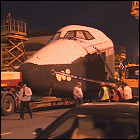 One of the last remaining prototypes of the Soviet-era Buran space shuttle is transported over land (and in pieces) from Gorky Park to an exhibition center in the center of Moscow to become part of an exhibit of Russian technological accomplishments. The unfinished Buran spaceframe had served numerous uses during its 30+ stay in Gorky Park, ranging from an impressive display piece to a diner (!).
One of the last remaining prototypes of the Soviet-era Buran space shuttle is transported over land (and in pieces) from Gorky Park to an exhibition center in the center of Moscow to become part of an exhibit of Russian technological accomplishments. The unfinished Buran spaceframe had served numerous uses during its 30+ stay in Gorky Park, ranging from an impressive display piece to a diner (!).
Buran buried
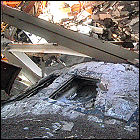 Stored in a hangar undergoing structural work at the Baikonur Cosmodrome in Kazakhstan, the Soviet-era Space Shuttle Buran is destroyed when that building collapses, an incident that also costs the lives of several workers at the site. Russian space officials deny that poor maintenance is an issue at the site; the Buran shuttle, the only Soviet shuttle to reach space, is damaged beyond repair.
Stored in a hangar undergoing structural work at the Baikonur Cosmodrome in Kazakhstan, the Soviet-era Space Shuttle Buran is destroyed when that building collapses, an incident that also costs the lives of several workers at the site. Russian space officials deny that poor maintenance is an issue at the site; the Buran shuttle, the only Soviet shuttle to reach space, is damaged beyond repair.
Buran grounded
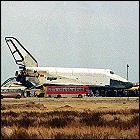 Russian President Boris Yeltsin brings an end to the secretive Soviet-era Buran project, which was the Soviet military’s answer to (and near-copy of) the American Space Shuttle fleet. Even though a second orbiter, Ptichka, is almost complete, and three others are in various stages of construction, Yeltsin and his advisors see no future for Buran and end the program as a cost-cutting measure. Due to its crash development and cost overruns, the Buran program has only launched a single unmanned shuttle on one orbital flight after the expenditure of the equivalent of $16,000,000,000.
Russian President Boris Yeltsin brings an end to the secretive Soviet-era Buran project, which was the Soviet military’s answer to (and near-copy of) the American Space Shuttle fleet. Even though a second orbiter, Ptichka, is almost complete, and three others are in various stages of construction, Yeltsin and his advisors see no future for Buran and end the program as a cost-cutting measure. Due to its crash development and cost overruns, the Buran program has only launched a single unmanned shuttle on one orbital flight after the expenditure of the equivalent of $16,000,000,000.
Buran’s only flight
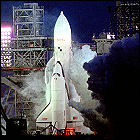 Modeled closely after the American Space Shuttle, the Soviet-built orbiter Buran lifts off for its first and only voyage into space. Still in the testing stages, Buran flies completely unmanned, with ground controllers at Baikonur Cosmodrome guiding the vehicle’s every move. With no large engines of its own (unlike NASA’s shuttle fleet), Buran is lifted into orbit solely by the giant Energia booster, makes two orbits, and returns home as a glider. A second flight is scheduled, but before it can take place, the Soviet Union collapses. Buran never flies again.
Modeled closely after the American Space Shuttle, the Soviet-built orbiter Buran lifts off for its first and only voyage into space. Still in the testing stages, Buran flies completely unmanned, with ground controllers at Baikonur Cosmodrome guiding the vehicle’s every move. With no large engines of its own (unlike NASA’s shuttle fleet), Buran is lifted into orbit solely by the giant Energia booster, makes two orbits, and returns home as a glider. A second flight is scheduled, but before it can take place, the Soviet Union collapses. Buran never flies again.
Buran Approach & Landing Test 1
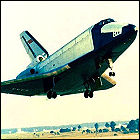 With its own jet engines freeing it from the need for a carrier aircraft, the Buran Analogue test vehicle – the Soviet equivalent of Space Shuttle Enterprise – makes its first approach and landing test, cutting off its jet engines at a predetermined altitude and gliding to an airstrip for a landing. The Buran Analogue will ultimately make more test flights than the Enterprise, continuing to conduct glider landings through 1988.
With its own jet engines freeing it from the need for a carrier aircraft, the Buran Analogue test vehicle – the Soviet equivalent of Space Shuttle Enterprise – makes its first approach and landing test, cutting off its jet engines at a predetermined altitude and gliding to an airstrip for a landing. The Buran Analogue will ultimately make more test flights than the Enterprise, continuing to conduct glider landings through 1988.
USSR plans next-generation space station
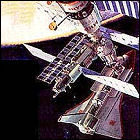 With work having started mere days earlier on Buran, a Soviet version of the American space shuttle design, the Soviet Union’s space agency is given new marching orders to create a new generation of space station hardware, based on the experience gained thus far with the four Salyut space stations and their associated Almaz military space hardware. A modular design is chosen, with multiple docking ports and multiple station components launched over a period of time, concepts which will be tested with yet-to-be-launched Salyut stations. Frequently fighting with the Buran shuttle development program for money and resources (despite the fact that the two spacecraft are expected to be compatible), this new station will not be launched until 1986, almost exactly ten years later, at which time it will be known as Mir.
With work having started mere days earlier on Buran, a Soviet version of the American space shuttle design, the Soviet Union’s space agency is given new marching orders to create a new generation of space station hardware, based on the experience gained thus far with the four Salyut space stations and their associated Almaz military space hardware. A modular design is chosen, with multiple docking ports and multiple station components launched over a period of time, concepts which will be tested with yet-to-be-launched Salyut stations. Frequently fighting with the Buran shuttle development program for money and resources (despite the fact that the two spacecraft are expected to be compatible), this new station will not be launched until 1986, almost exactly ten years later, at which time it will be known as Mir.
Soviet shuttle startup
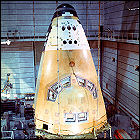 Fearing that the relatively sleek, aerodynamic design of the still-unflown American Space Shuttle is a hint that the vehicle could see use as an orbital bomber, the Kremlin orders the creation of the Soviet Space Shuttle program, though work on the vehicle, codenamed Buran (“Snowflake”), is primarily a crash program within the country’s defense department rather than the civilian branch of its space program. Within months, it is concluded that Buran will closely copy the American shuttle design due to the soundness of its aerodynamic design.
Fearing that the relatively sleek, aerodynamic design of the still-unflown American Space Shuttle is a hint that the vehicle could see use as an orbital bomber, the Kremlin orders the creation of the Soviet Space Shuttle program, though work on the vehicle, codenamed Buran (“Snowflake”), is primarily a crash program within the country’s defense department rather than the civilian branch of its space program. Within months, it is concluded that Buran will closely copy the American shuttle design due to the soundness of its aerodynamic design.